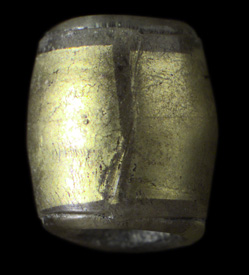 STUDIO PHOTOGRAPHS
STUDIO PHOTOGRAPHSIntroduction | Research | People | Tools
 STUDIO PHOTOGRAPHS
STUDIO PHOTOGRAPHS
GLASS BEAD (TYA 642: 2835)
Type: Metal-foil bead.
Use: Jewel.
Site: Raisio, Ihala, Mulli abode.
Period: Viking Age / Crusade Age / Early Middle Ages
Dating: 980-1220 A.D.
Weight: 2 g.
Photographer: Antti Huittinen.
During the late Iron Age, bead-strings may have been a common part of female jewelry. Beads were made of glass, clay, bone, metal , carnelian, amber and soapstone.
Metal foil beads, such as this one, that contain a thin metal layer under glass, were made already in the Roman Empire. Metal-foil beads were manufactured by rolling the surface of a bead, which was cut of a blown glass tube, in molten metal. When the metal solidified, the bead was rolled in molten glass so that a covering layer of glass comes on the metal layer. The colour of the metal-foil bead does not, however, necessarily reveal the metal used in the preparation. The gold-like yellow color may be caused by the yellowish tone of the covering glass. The metal used is possibly silver.
This barrel-shaped metal-foil bead is possibly from the 11th century. It may be of eastern origins.
Other pictures:
Other related topics:
Introduction | Research | People | Tools